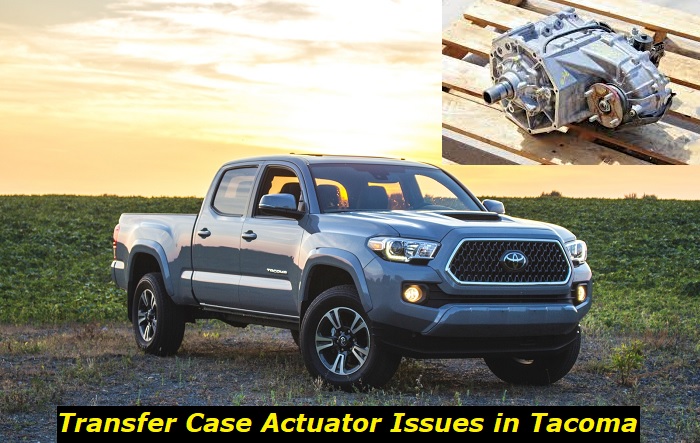The Toyota Tacoma has four generations with the last one being introduced in 2023. One common issue that users of the Toyota Tacoma face across its first three generations is the transfer case actuator fault. You're in the right place to get repair tips concerning this actuator.
The reasons for the Toyota Tacoma's actuator failing usually include a voltage irregularity, shorting in the unit, wrong positioning, bad connection, etc. These situations can be diagnosed and fixed and we'll describe how in this comprehensive guide. But keep in mind that the most common repair is to swap out the actuator.

You'll find so many online forum threads dealing with this issue because Toyota released little information about the problem over the decades until recent years. We've researched them along with several valuable articles on the subject.
The Toyota Tacoma's Transfer Case and Its Actuator
The transfer case (T-case) of a Tacoma is a device that is connected to the vehicle's engine to transfer power from the engine to the drive shafts. In turn, the drive shafts will turn the wheels. T-cases link the rear drive axle to that of the front when triggered. They also ensure reduction gearing when enabled in low gearing.
Transfer cases also contain gears that let your Tacoma get driven in either two-wheel-drive or four-wheel-drive (2WD or 4WD). Most transfer cases in the automotive world are worked manually, meaning that the driver has to choose the preferred mode of operation.
Some recent model-year transfer cases such as the ones in newer Tacoma pickups are automatically regulated. You can keep your transfer case in good working condition by performing routine checks on it. You would have little or no worries about its actuator getting bad if you do so, especially checking the fluid level regularly.
The Transfer Case and the Automatic Differential Disconnect (ADD)
Your truck's 4WD system will feature a T-case that's located near the engine with the front ADD (Automatic Differential Disconnect). The ADD engages/disengages a sliding sleeve that can be found on the front axle. It possesses two working positions that can be referred to as "locked in 4Hi or 4Lo" and "unlocked in 2Hi".
Transfer Case Actuator in a Tacoma
The transfer case actuator is a motor that ensures that the transfer case performs its functions well. In other words, it has the important role of ensuring the engaging and disengaging of a 4WD system by locking up the differential (diff) when switching to 4WD mode. It doesn't matter if it's 4H or 4L.
T-cases work with the aid of gears and shift forks. The engagement of the axle will make it turn and greatly improve your Tacoma's off-roading performance. So suspect a mechanical or electrical issue with the actuator (whole relay system) when your truck can't switch gears on the fly.
The workings of the T-case actuator are important when you're driving on low-traction or when you need to make all the pickup's wheels spin simultaneously.
Note: Old model-years of 4WD actuators utilized vacuum hoses that made use of pressurized air to work the gears and lock the differential.
Toyota Tacoma Transfer Case Actuator Failure
A faulty actuator is a well-known issue with the Tacoma's four-wheel-drive (4WD) system. As stated earlier, the actuator is situated on the transfer case but it's linked to the engine. The four-wheel-drive models of the fourth-generation Toyota Tacoma have two-speed (high and low range) T-cases that are regulated electronically.
The 4WD drivetrain comes installed with many sensors and parts. But as minor as the T-case actuator is, it's still a crucial component in the smooth driving of four-wheelers. It may be unnoticeable for a long time or you may not remember its existence till it develops a fault.
Nonetheless, you can get suspicious of this part's failure when the 4WD becomes difficult to engage, is stuck, or refuses to activate. Any of these symptoms should compel you to check the unit ASAP. A delay in examining the unit could lead to serious and expensive damages to the drivetrain.
The most common reason for a transfer case actuator failure is because of a voltage issue. The switch won't be able to perform its function of engaging and disengaging the four-wheel-drive system if there's little or no voltage being passed to it.
Diagnosis and Fixes
Low Voltage
Low voltage in the actuator can be caused by a faulty switch or relay. The solution here is to replace the switch or relay. Ensure that you get a compatible aftermarket part that fits your generation of Tacoma. Even the transfer cases for each generation have various versions.
You can find the unit beneath the floor pan. Access it by removing the floor pan. Then you can uninstall the old actuator and swap in the replacement part. The replacement should only take 30 minutes to carry out. Expect to pay over $1,000 for the swap or less, depending on the Tacoma model year.
Checking a Faulty Transfer Case Actuator for Faults on the Old Generations of Tacoma
Diagnosing and repairing a T-case that wouldn't let the vehicle engage 4Hi or 4Lo should be easier to do with the tips we have for you in this section. We used the third generation as an example for the troubleshooting problems you may be having as regards the actuator.
The Three Operating Positions of the Actuator are stated below.
- 2Hi just going directly through the case to the rear axle (1:1)
- 4Hi driving both the front axle and rear axle (1:1)
- 4Lo driving both the front and rear axles (2.57:1)
1) Wiring/Electrical Components
You may notice the shift indicator blinking and the truck remaining in 2WD/rear-wheel when the 4WD Hi or Lo can't be engaged. Find out if the root of the problem is the actuator by checking the state of the wire connections from the 4WD module to the T-case actuator. All the power and grounds for the system should be examined.
2) ECU Monitoring with a Scan Tool
Keep in mind that each actuator has a motor and position feedback wipers. You can use a diagnostic tool that's compatible with your Toyota Tacoma to perform this check and get all the relevant data. Scanning and monitoring will start once you put on the engine
The scanner will check the actuators for motor resistance. It will also ensure that the position feedback wipers are giving an acceptable result. The ECU will drive the actuators to their optimal positions once the resistance and feedback are deemed OK.
However, the ECU will log in a code when the results aren't satisfactory on starting the engine. This will prevent further mode changes and freeze the system in the current settings.
3) Ohmmeter ADD and Ohmmeter Transfer Case Checks
The best way to reach the ADD is via the front axle after getting the transmission cover out of the way. As for the Ohmmeter transfer case assessment, note that the T-case connector has 12 pins.
4) Actuator Positioning
Also, as mentioned earlier in the introduction, it might be that the actuator isn't well-positioned on the ADD. You should examine the former's connection with the latter to ascertain this.
Swapping out the actuator is a complex procedure because of its many internal parts and working. But you may be able to pull it off easily if you have worked on the transfer case before. You'd have to remove the T-case or partially disassemble it to get to the actuator.
Maintaining the Transfer Case Actuator
Just like other moving parts of your Tacoma, the T-case actuator also needs to be properly maintained. So you have to remember to check its working condition when examining the T-case as a whole. It should never be overlooked when there's a suspected case of T-case malfunction.
Every part of the actuator like the locking collar, shift fork, and gears must be looked at and maintained regularly. Check for corrosive materials, damage, moisture, and too much friction while it's being operated.
Maintenance and servicing of the actuator by a professional is highly recommended. It's a safer approach with minimal risk of the unit being shorted, wrongly installed, or damaged.
Conclusion
We don't know what awaits buyers of the Toyota Tacoma's fourth generation as regards the transfer case actuators in each vehicle. But we can be sure that Toyota will be upgrading the actuators for the new generation. So expect the units to last longer before they start getting faulty.
As for users of the old model-year Tacoma vehicles, they should aim for standard replacement parts when trying to swap out the old actuators. They're sure to have high durability. It's a better investment than buying substandard products that will leave you returning to the market for another replacement part in a short time.
About the authors
The CarAraC research team is composed of seasoned auto mechanics and automotive industry professionals, including individuals with advanced degrees and certifications in their field. Our team members boast prestigious credentials, reflecting their extensive knowledge and skills. These qualifications include: IMI: Institute of the Motor Industry, ASE-Certified Master Automobile Technicians; Coventry University, Graduate of MA in Automotive Journalism; Politecnico di Torino, Italy, MS Automotive Engineering; Ss. Cyril and Methodius University in Skopje, Mechanical University in Skopje; TOC Automotive College; DHA Suffa University, Department of Mechanical Engineering






Add comment